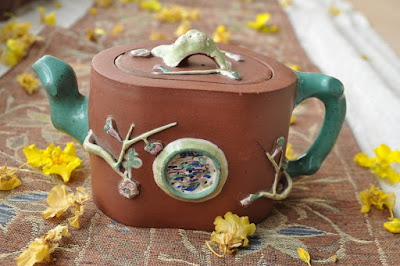After the clays and the clay making, let's examine how Yixing teapots take shape. As part of this lecture, Teaparker asked the students of the Tea Institute to draw the same Xishi teapot from where they were sitting. This exercise forces them to look at the teapot very carefully and see its details.
The actual making of an Yixing teapot can be seen on this video.
The teapots can then be categorized into 3 big categories:
1. Geometrical shape (mostly round, square, hexagonal...)
2. Petal shapes (pumpkin or flower shaped).
3. Inspired by nature. Let's see a few examples of this style. See the handle of this teapot: it looks like bamboo. And the spout looks like the branch from a tree.
This Jianquan teapot dates back to the early 20th century. Beside the painting, we can also see that some decoration (a branch of a pine tree) has been applied on the body of the teapot.
And on the cover, it's plum blossoms that come alive on the otherwise dead branch!
This style of Yixing teapot, based on a log from tree, is a good example of how Yixing teapot makers have been using the same shapes for a very long time.
Sometimes, it's adapted to a certain fashion, like the coloring of some important parts of the teapot on the previous and this teapot.
An important principle to study ancient Yixing teapots is to head to the museums where the origin and date can be most trusted. For this log and plum flower shaped teapot, I could find a very similar piece from the 19th century online from the Freer and Sackler Galleries.
The details of this younger teapot are nicely executed but the inside of the teapot still needs some brushing.
The following zisha teapot, however, starts to shine naturally as I have started testing it.
This clay has a chocolate color that looks so delicious!
Plum blossoms are the rare flowers to bloom in winter. Here, the winter is represented by a log, a piece of wood without leaves. It's almost dead already (in the winter of its existence), but the plum blossoms (mei) are beautiful. They represent hope, the fact that in the hardest conditions you can still find ways to blossom.
These classic shapes continue to be used or reinvented today.
This zisha teapot dramatizes the handle and the wood attributes.
The plum blossoms are also made with a different, slightly redder clay.
These nature inspired teapots have more complexity than most round teapots. They carry also more symbols rooted in Chinese culture! These wood/log shaped teapots are a nice fit for the autumn season! They bring us close to nature and into the woods!
























3 comments:
wow, these look really great! Thank you also for the very interesting video.
Where can I learn about these events before they happen? It's about 200 miles from me, but for an event like that I would have tried to make it over for the weekend! It looks like an amazing presentation.
Thanks miig!
And thanks Lisa. I've informed my readers of this event beforehand. So read my blog more often ;) !
Or you may check the site of the PSU Tea Institute for their announcements:
http://sites.psu.edu/teainstitute/
Hope to see you next spring then.
Post a Comment